By Wendi Schnaufer
In August 2007, I met with the store managers of a Whole Foods and a Kroger (comparable to a Giant) supermarket in the Detroit suburbs to see how the beverage bottle and can redemption process works there for consumers and retailers.
Consumers pay a 10-cent deposit on soft drinks, beer, and some other bottled and can beverages but not on bottled water. Post-consumption, it is a way of life to rinse these containers and store them, returning them to the place of purchase for a refund when convenient. Most Michiganders shop at supermarkets and return the bottles and cans there when shopping.
Whole Foods in West Bloomfield, which sells a limited number of one-use beverages and not the major mainstream brands (no Coke, etc.), surprisingly had a low-tech redemption operation. Customers brought the bottles and cans to the service desk and the clerk sorted the bottles by brand in Rubbermaid bins (about 8 by 24 inches) stored on some shelves right there. The clerk would hand tally the count and either refund the customer there or give the customer a slip to redeem at checkout. In the back storage area, about 3 metal chef shelves were barely stacked with boxes sorted by brand. The regional Chicago office took care of managing the pickup for these every so often. The manager did not know the numbers but thought their redemption efforts were not profit-making. West Bloomfield does not have curbside recycling.
I had expected a reverse vending machine at the entrance to the store. The manager said they did not have these because of the dirt and esthetics, but the low volume of sales and returns also must play a role.
The Kroger supermarket had the typical high-tech beverage redemption operation of the chain stores, where most Michiganders shop. The Bloomfield Hills location was in a strip of stores and so had less volume than other stand-alone superstores in the area. Customers bring their plastic and glass beverage bottles and cans to a room at the back of the store that is about 8 by 15 feet. There is a reverse vending machine for glass, for plastic bottles, and for cans.
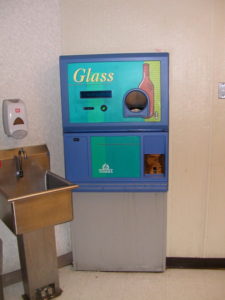
Reverse vending machine for glass beverage containers in the back room of Kroger
The customer places the containers one by one into the hole into the appropriate machine. The machine tallies the count and issues a paper slip with the amount to be refunded.
The customer takes this to the checkout to get the refund.
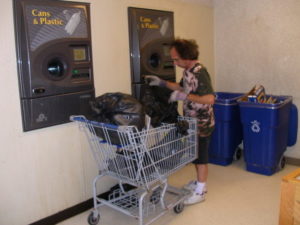
Hard-core customer (he even has gloves) returning a load of pop containers
On the other side of these machines, in the employee-only area,the back side of the machines spit out the cans and bottles into separate large bins (5 x 4 x 4?) on rollers that are housed in a steel cabinet.
The plastic bottles and cans are compressed.
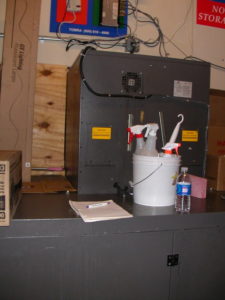
Part of the back of the vending machine.
The shoot for the containers is in the top box and the lower portion houses the bins. The doors on this back side open and the full bins can be wheeled out.
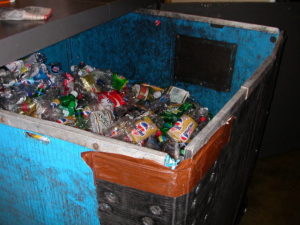
Bin pulled out from the housing
The operation is largely operated electronically, with sensors notifying UBCR, LLC, the beverage container and recycling company that handles the post-store recycling,
when to pick up the approximately 5 full bins, for this store about every 10 days, and crediting the store with their handling fee.
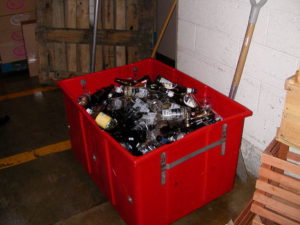
Bin off to the side, ready for recycling pick-up
The manager said the superstores might ship out 18-24 of these bin loads in that period.
In terms of maintenance of the customer redemption room, the manager said the cleaning up was tolerable, with sticky floors. It was no big deal and an extra bagger was assigned to clean the room once per day. He said it was a money-losing operation but a good thing; his father lived in D.C. and he knew the problem we have here and said that Maryland needed a bottle bill as well.
This process complements curbside recycling in many Michigan communities. In Franklin, residents have the usual recycling bin, and number 1 and 2 plastics, cans, and food and other beverage container glass are picked up, along with newspapers, etc. If one did not want to be bothered to take back the deposit beverage recyclables to the store, one could put these out at the curbside.
Michigan’s beverage container redemption rate is 95%; Maryland’s is probably in the 30% range, the nation’s average for non-deposit states.


